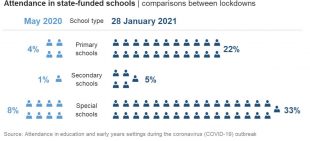What the latest attendance stats show us

The latest attendance stats from @EducationGovUK highlight a different picture than during the first lockdown last year:
A higher proportion of children who can‘t access remote education are in school while more pupils have access to devices so they can learn from home.
A Department for Education spokesperson said:
“We continue to provide laptops and tablets at huge speed and scale for those children who need them the most. Almost one million have now been delivered to schools and councils from the 1.3 million being provided, with just under 425,000 delivered since the beginning of January, when schools closed to most pupils. This is helping ensure children can continue to receive the best possible education while at home.
“Schools remain open to vulnerable children and children of critical workers, but if critical workers can work from home and look after their children at the same time then they should do so.”
We are taking every possible measure to reduce covid cases and the protective measures that schools have been following throughout the autumn term continue to be in place to help protect staff and students, while the national lockdown helps reduce transmission in the wider community.
This means we can be confident that pupils are receiving a better standard of education than in the spring and this is thanks to a number of changes the department has implemented over the course of the pandemic.
Currently, 99% of schools are currently open compared to 80% in May 2020 and overall attendance in all settings is up. We are reassured that our most vulnerable children continue to receive the quality education they deserve.
Rapid testing is also now available to staff and students in secondary schools and colleges, and is shortly rolling out to primary school staff, to help identify asymptomatic cases, break chains of transmission and help reduce the spread of the virus amongst those on site.
The current national measures are driving the R rate down and we hope to be able to start welcoming back more pupils from 8 March at the earliest. It is important to reiterate that we do not see this as a ‘return to school’ but more of an expansion of the numbers of pupils already in school and receiving a face to face education.
We have extended the definition of vulnerable so that those who can’t access online learning at home are able to attend school. On top of this around 36% of children with an Education, Health and Care Plan (EHCP) were in attendance on 28 January, and 43% of children with a social worker were in school. We have also provided devices at huge speed and scale for those children who need them the most, with over 927,000 laptops now delivered to schools and councils. Over 365,000 of these have been delivered since the start of January, helping ensure no child loses out while learning at home. The result of this is that more pupils are getting education at home and more are getting quality face to face education in school, meaning that overall, more pupils are still receiving a quality education despite the restrictions.











Responses